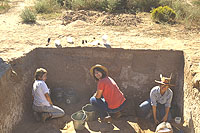
El Paso Archaeological Society members working on the
excavation of Room 25, one of the deep pithouses under
the pueblo. Left to right: Chris Ward, Betsy Smith, Martha
Sharp. Chris Ward went on to become a professional archeologist.
She studied at UT Austin, worked at TARL, and is now a
Ph.D. student at the University of Colorado. |
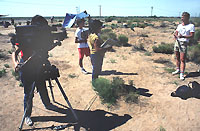
Film crew interviewing field director
Tom O'Laughlin for segment in video documentary, "The
Rock Art of Texas," a production of the Texas Parks
and Wildlife Department.
|
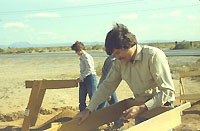
Dr. Vern Scarborough, then of UT El Paso, now of the University
of Cincinnati, works with some of his students at Firecracker
Pueblo. Students in anthropology courses used collections
from the site in research projects and received extra
credit for assisting in the excavations. |
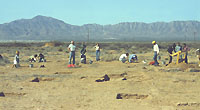
University students participate in the systematic excavation
on a grid of extramural areas.
|
|
Excavations at Firecracker Pueblo began in July
of 1980, and fieldwork was completed in December of 1990.
The length of the project and the proximity of the site to
a major highway provided many opportunities to promote archeology
and engage the public with the rich history of the region.
There were the usual newspaper and magazine articles and a
variety of television and radio programs featuring new finds
or activities. There were also numerous informal and formal
presentations of the "in-progress" investigation
to archeological and historical societies and other civic
or social organizations in Texas and New Mexico and the annual
meetings of TAS and the Archaeological Society of New Mexico.
The location of the site within a few feet of
Highway 54 did create an interesting situation. Throughout
the project, everyone from truck drivers to people on the
way to Ruidoso to ski to whole families would stop and ask
what we were doing. These were not just a few people but a
constant flow of people that probably numbered in the thousands
over the years. It gave us an opportunity to show off the
site and talk about the past and the role of archeologists.
It also brought many volunteers to the project. Some people
quit what they were doing that day and pitched in on the spot
with the work at hand. Others became regular volunteers for
the excavation and later for the lab work. Some joined the
El Paso Archaeological Society (EPAS) and a few even went
back to college for credit or non-credit courses in anthropology
and history. In many cases entire families became involved,
including several instances of three generations of the same
family working together at the site.
Through the Department of Sociology and Anthropology
at the University of Texas at El Paso, students were afforded
the opportunity to earn credit for working at the site or
through using materials from the site in analytical or laboratory
courses. Also through the university and Insights, the local
science museum, support was provided for a series, Art and
Archaeology. This was a program for children 10 to 14 years
in age that combined elements of art, archeology and Southwestern
cultures and incorporated fieldwork at the site and classroom
projects with artifacts from the site. As a separate project,
Sunrise Publications produced in 1994 a children's book and
companion video simply entitled Firecracker Pueblo.
There have been exhibits of photographs and
artifacts from Firecracker Pueblo in museums and libraries
of El Paso, and a large mural of what the site may have looked
like during its occupation is installed at the Institute of
Texan Cultures in San Antonio. Finally, the 1986 TAS field
school at Firecracker Pueblo was featured in a Texas Parks
and Wildlife video called The Rock Art of Texas. All
in all, Firecracker Pueblo found its way into a lot of things
public.
|
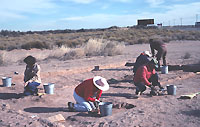
On a bitter cold January day, EPAS
members begin work on the site's largest structure,
Room 6.
Click images to enlarge
|
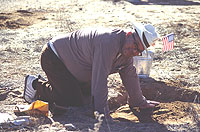
EPAS member Jerry Goff celebrates
the 4th of July in his own way—it is, after all,
Firecracker Pueblo.
|
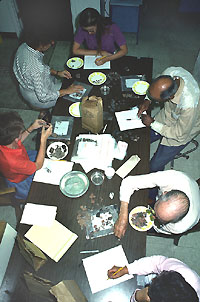
Fieldwork was conducted at Firecracker
Pueblo over a 10-year period. Lab work ran concurrently
and for another 5 years following the excavations. Once
a week, the crew met to clean, sort, catalogue, identify,
measure, and analyze artifacts, faunal and floral remains,
and flotation samples. They are the unsung heroes of
this project.
|
|